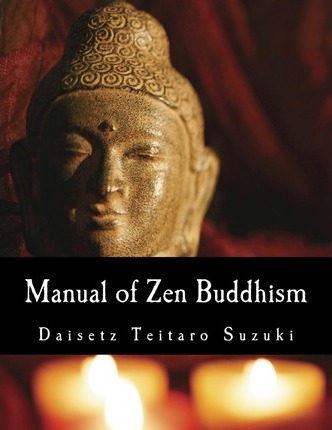Manual of Zen Buddhism

Manual of Zen Buddhism
Daisetsu Teitaro Suzuki was a Japanese author of books and essays on Buddhism, Zen and Shin that were instrumental in spreading interest in both Zen and Shin (and Far Eastern philosophy in general) to the West. Suzuki was also a prolific translator of Chinese, Japanese, and Sanskrit literature. Suzuki spent several lengthy stretches teaching or lecturing at Western universities, and devoted many years to a professorship at Otani University, a Japanese Buddhist school. Besides living in the United States, Suzuki traveled through Europe before taking up a professorship back in Japan. In 1911, Suzuki married Beatrice Erskine Lane, a Radcliffe graduate and Theosophist with multiple contacts with the Baha Faith both in America and in Japan. Later Suzuki himself joined the Theosophical Society Adyar and was an active Theosophist. While he was in Kyoto, he visited Dr. Hoseki Shinichi Hisamatsu, a famous Zen Buddhist scholar, and discussed Zen Buddhism together at Shunkoin temple in the Myoshinji temple complex. In 1921 he and his wife, Beatrice, founded the Eastern Buddhist Society; the Society is focused on Mahayana Buddhism and offers lectures and seminars, and publishes a scholarly journal. Besides teaching about Zen practice and the history of Zen (Chinese Chan) Buddhism, Suzuki was an expert scholar on the related philosophy called, in Japanese, Kegon, which he thought of as the intellectual explication of Zen experience. In addition to his popularly oriented works, Suzuki wrote a translation of the Lankavatara Sutra and a commentary on its Sanskrit terminology. He looked in on the efforts of Saburo Hasegawa, Judith Tyberg, Alan Watts and the others who worked in the California Academy of Asian Studies (now known as the California Institute of Integral Studies), in San Francisco in the 1950s. Suzuki is often linked to the Kyoto School of philosophy, but he is not considered one of its official members. Suzuki took an interest in other traditions besides Zen. His book Zen and Japanese Buddhism delved into the history and scope of interest of all the major Japanese Buddhist sects. In his later years, he began to explore the Jodo Shinshu faith of his mother's upbringing, and gave guest lectures on Jodo Shinshu Buddhism at the Buddhist Churches of America. D.T. Suzuki also produced an incomplete English translation of the Kyogyoshinsho, the magnum opus of Shinran, founder of the Jodo Shinshu school. However, Suzuki did not attempt to popularize the Shin doct
PRP: 61.46 Lei
Acesta este Pretul Recomandat de Producator. Pretul de vanzare al produsului este afisat mai jos.
55.31Lei
55.31Lei
61.46 LeiLivrare in 2-4 saptamani
Descrierea produsului
Daisetsu Teitaro Suzuki was a Japanese author of books and essays on Buddhism, Zen and Shin that were instrumental in spreading interest in both Zen and Shin (and Far Eastern philosophy in general) to the West. Suzuki was also a prolific translator of Chinese, Japanese, and Sanskrit literature. Suzuki spent several lengthy stretches teaching or lecturing at Western universities, and devoted many years to a professorship at Otani University, a Japanese Buddhist school. Besides living in the United States, Suzuki traveled through Europe before taking up a professorship back in Japan. In 1911, Suzuki married Beatrice Erskine Lane, a Radcliffe graduate and Theosophist with multiple contacts with the Baha Faith both in America and in Japan. Later Suzuki himself joined the Theosophical Society Adyar and was an active Theosophist. While he was in Kyoto, he visited Dr. Hoseki Shinichi Hisamatsu, a famous Zen Buddhist scholar, and discussed Zen Buddhism together at Shunkoin temple in the Myoshinji temple complex. In 1921 he and his wife, Beatrice, founded the Eastern Buddhist Society; the Society is focused on Mahayana Buddhism and offers lectures and seminars, and publishes a scholarly journal. Besides teaching about Zen practice and the history of Zen (Chinese Chan) Buddhism, Suzuki was an expert scholar on the related philosophy called, in Japanese, Kegon, which he thought of as the intellectual explication of Zen experience. In addition to his popularly oriented works, Suzuki wrote a translation of the Lankavatara Sutra and a commentary on its Sanskrit terminology. He looked in on the efforts of Saburo Hasegawa, Judith Tyberg, Alan Watts and the others who worked in the California Academy of Asian Studies (now known as the California Institute of Integral Studies), in San Francisco in the 1950s. Suzuki is often linked to the Kyoto School of philosophy, but he is not considered one of its official members. Suzuki took an interest in other traditions besides Zen. His book Zen and Japanese Buddhism delved into the history and scope of interest of all the major Japanese Buddhist sects. In his later years, he began to explore the Jodo Shinshu faith of his mother's upbringing, and gave guest lectures on Jodo Shinshu Buddhism at the Buddhist Churches of America. D.T. Suzuki also produced an incomplete English translation of the Kyogyoshinsho, the magnum opus of Shinran, founder of the Jodo Shinshu school. However, Suzuki did not attempt to popularize the Shin doct
Detaliile produsului








